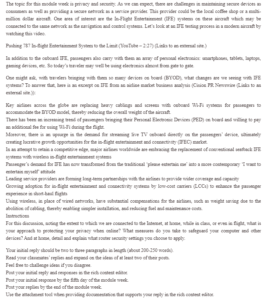Question The topic for this module week is privacy and security. As we can expect, there are challenges in maintaining secure devices as consumers as well as providing a secure network as a service provider. This provider could be the local coffee shop or a multi-million dollar aircraft. One area of interest is the In-Flight Entertainment (IFE) systems on these aircraft, which may be connected to the same network as the navigation and control systems. Let’s look at an IFE testing process in a modern plane by watching this video. Privacy and Security Pushing 787 In-flight Entertainment System to the Limit (YouTube – 2:27) (Links to an external site.) In addition to the onboard IFE, passengers also carry with them an array of personal electronics: smartphones, tablets, laptops, gaming devices, etc. So, today’s travelers may well be using electronics almost from gate to gate. One might ask, with travelers bringing with them so many devices on board (BYOD), what changes are we seei
Privacy and Security
Privacy can refer to policies and measures that are accorded a use in terms of how their data will be used. On the other hand, security refers to the techniques used to prevent malicious users from accessing data without authorization. Privacy and security have become a multi-billion-dollar industry, with both service providers and users playing a part in protecting their devices (Chatterjee, Benoist & Nath, 2020).
Some of the steps I take to enhance privacy and security on my devices include always reading the terms and conditions before installing new software or applications on my machine. I also ensure my devices always have anti-virus software installed, which is helpful in preventing and removing malicious software from my devices. Additionally, when connected to the Internet on a public network, I use a virtual private network (VPN) to ensure my data is not compromised by other users on the web.
When setting up a router for accessing the Internet, the first security measure is to change the default password and set a new password that contains letters, numbers, and symbols. Most routers come with a default password that is similar to all other routers of the same model. Router encryption should also be changed to WPA 2 if the router uses any different type of security encryption. Previous versions of router encryption have become obsolete and contain security flaws that malicious users can use to gain access to sensitive information (Ali et al., 2018). It is also advisable to turn off WPS support. We offer assignment help with high professionalism.
References
Ali, S., Islam, N., Rauf, A., Din, I. U., Guizani, M., & Rodrigues, J. J. (2018). Privacy and security issues in online social networks. Future Internet, 10(12), 114.
Chatterjee, P., Benoist, E., & Nath, A. (Eds.). (2020). Applied Approach to Privacy and Security for the Internet of Things. IGI Global.
Question The topic for this module week is privacy and security. As we can expect, there are challenges in maintaining secure devices as consumers as well as providing a secure network as a service provider. This provider could be the local coffee shop or a multi-million dollar aircraft. One area of interest is the In-Flight Entertainment (IFE) systems on these aircraft, which may be connected to the same network as the navigation and control systems. Let’s look at an IFE testing process in a modern plane by watching this video. Privacy and Security Pushing 787 In-flight Entertainment System to the Limit (YouTube – 2:27) (Links to an external site.) In addition to the onboard IFE, passengers also carry with them an array of personal electronics: smartphones, tablets, laptops, gaming devices, etc. So, today’s travelers may well be using electronics almost from gate to gate. One might ask, with travelers bringing with them so many devices on board (BYOD), what changes are we see
Privacy and Security
Privacy can refer to policies and measures that are accorded a use in terms of how their data will be used. On the other hand, security refers to the techniques used to prevent malicious users from accessing data without authorization. Privacy and security have become a multi-billion-dollar industry, with both service providers and users playing a part in protecting their devices (Chatterjee, Benoist & Nath, 2020).
Some of the steps I take to enhance privacy and security on my devices include always reading the terms and conditions before installing new software or applications on my machine. I also ensure my devices always have anti-virus software installed, which is helpful in preventing and removing malicious software from my devices. Additionally, when connected to the Internet on a public network, I use a virtual private network (VPN) to ensure my data is not compromised by other users on the web.
When setting up a router for accessing the Internet, the first security measure is to change the default password and set a new password that contains letters, numbers, and symbols. Most routers come with a default password that is similar to all other routers of the same model. Router encryption should also be changed to WPA 2 if the router uses any different type of security encryption. Previous versions of router encryption have become obsolete and contain security flaws that malicious users can use to gain access to sensitive information (Ali et al., 2018). It is also advisable to turn off WPS support. We offer assignment help with high professionalism.
References
Ali, S., Islam, N., Rauf, A., Din, I. U., Guizani, M., & Rodrigues, J. J. (2018). Privacy and security issues in online social networks. Future Internet, 10(12), 114.
Chatterjee, P., Benoist, E., & Nath, A. (Eds.). (2020). Applied Approach to Privacy and Security for the Internet of Things. IGI Global.
